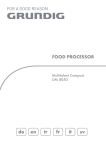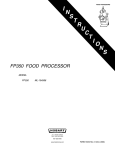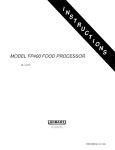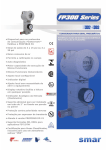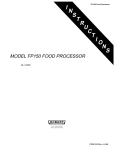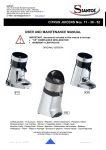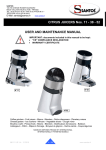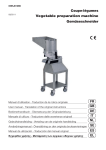Download Hobart FP300 User's Manual
Transcript
IN S TR U C TI MODEL FP300 FOOD PROCESSOR O N S FP300 FOOD PROCESSOR MODEL FP300 ML-104495 701 S. RIDGE AVENUE TROY, OHIO 45374-0001 FORM 19157 Rev. B (11-98) Installation, Operation, and Care of MODEL FP300 FOOD PROCESSOR SAVE THESE INSTRUCTIONS GENERAL The FP300 Food Processor is used for slicing, shredding, grating, Julienne cutting and dicing vegetables, fruits, or cheese. The compact unit is designed for ease of operation and quick cleaning. A Work Table, a Wall Rack, and a wide range of slicer, shredder, and dicing plates are available options. INSTALLATION UNPACKING Immediately after unpacking the FP300, check for possible shipping damage. If the Food Processor is found to be damaged, save the packaging material and contact the carrier within 15 days of delivery. Prior to installation, test the electrical service to assure that it agrees with the specifications on the data plate located at the rear. Do not lift the unit with any hinged or extended parts; lift only with one hand under the protruding lip at the rear near the base of the motor compartment and the other hand underneath the chute. LOCATION The FP300 should be operated on a suitable counter height surface. A pan (not provided), suitable for kitchen use, can be used to capture the product at the exit chute. © HOBART CORPORATION, 1994 –2– ELECTRICAL CONNECTION WARNING: THE ELECTRICAL CORD HAS A THREE-PRONGED GROUNDING PLUG WHICH MUST BE CONNECTED TO A PROPERLY GROUNDED RECEPTACLE. IF THE RECEPTACLE IS NOT THE PROPER GROUNDING TYPE, CONTACT AN ELECTRICIAN. DO NOT REMOVE THE GROUNDING PRONG FROM THE PLUG. ELECTRICAL DATA Model FP300 Volts / Hz / Phase 120 / 60 / 1 Amps 10 OPERATION WARNING: ROTATING KNIVES INSIDE. ALWAYS USE PUSHER PLATE. KEEP HANDS OUT. Proper assembly of the FP300 including selection of the appropriate cutters is necessary for correct operation of the food processor (Figs. 1 & 2). Refer to the Cutting Tool Guide for sizes of cutters and refer to the appropriate operation instructions. CONTROLS START (Green) — Push to start. STOP (Red) — Push to stop. Interlock switches prevent the machine from operating when the feed hopper is out of position or the pusher plate is raised above the feed hopper. If these features do not function as described, contact your local Hobart service office. During operation, when the pusher plate is fully raised above the feed hopper, the machine stops and allows the pusher plate to be rotated counterclockwise for loading. To continue operation, rotate the pusher plate clockwise until it is directly above the feed hopper; as the pusher plate begins to lower into the hopper, the machine will restart — you do not need to push the green START switch unless STOP was pressed. Always push the red STOP switch before changing cutters or cleaning. –3– Operations with a Single Plate — (Fig. 1) SLICING, SHREDDING, GRATING, AND JULIENNE CUTTING 1. Raise the pusher plate using the pistol grip handle and turn it to the left. 2. Release the feed hopper lock by turning the finger paddle counterclockwise. Then raise the feed hopper. 3. Lower the flinger plate on the knife shaft until the flinger plate seats on the shaft pin. 4. Select the appropriate plate for the job. Place the plate on the shaft, turning until engaged. 5. Lower the feed hopper. NOTE: When the pusher plate is rotated and lowered, the feed hopper will automatically be locked. Fig. 1 Operations with Two Plates — (Fig. 2) DICING AND FRENCH FRIES 1. Raise the pusher plate and turn it to the left. 2. Release the feed hopper lock by turning the finger paddle counterclockwise. Then raise the feed hopper. 3. Lower the flinger plate on the knife shaft until the flinger plate seats on the shaft pin. 4. Select the proper size dicing plate and place it correctly on the knife shaft above the flinger plate. Select the appropriate slicing plate for the job (see Cutting Tool Guide). Place the slicing plate on the shaft, turning until engaged. 5. Lower the feed hopper. NOTE: When the pusher plate is rotated and lowered, the feed hopper will automatically be locked. Fig. 2 –4– USING THE FEED HOPPER After the pusher plate is raised, pre-pared products, such as potatoes, carrots, onions, lettuce, cabbage, etc. can be placed in the large feed hopper. When cutting French fries with the Julienne cutter, position the potatoes at the lower-right corner of the large feed hopper. The potatoes may be stacked to cut several at one time. NOTE: For consistent results, stack product in the lower-right corner of the feed hopper, one pile only. The large feed hopper is also used to slice round products, such as lemons and tomatoes. Position the product in the lower-right corner of the feed hopper. NOTE: For best results, it is advisable to remove tops and tails from products like lemons, limes, or onions and place them in the hopper perpendicular to the desired cut. USING THE FEED TUBE Twist the knob to release the catch on the feed tube pusher and pull out to expose the feed tube opening. The feed tube is used for slicing long, thin shaped products, such as cucumbers or carrots or to contain small items like radishes. The machine does not stop when the feed tube pusher is removed; this allows products to be processed continuously. Always use the feed tube pusher. CLEANING WARNING: TURN THE MACHINE OFF AND UNPLUG THE ELECTRICAL CORD BEFORE CLEANING. Clean the machine immediately after each use. Dismantle all removable parts from the machine and wash them in warm water and detergent. Rinse thoroughly and wipe dry with a soft clean cloth. NOTE: Allowing food juices to dry on the machine may cause discoloration. NEVER clean feed hopper, cutting tools or other aluminum parts in highly alkaline dishwashing solutions or in excessively hot water as this can cause formation of aluminum oxide (black). DO NOT USE steel wool or sharp objects for cleaning machine surfaces if they become discolored; scratched surfaces become hard to keep clean. 1. Remove feed tube pusher and rinse in luke warm water. Raise the pusher plate; turn it to the left. 2. Remove the feed hopper and rinse it in luke warm water. 3. Lift out the cutting plate. If you have used the dicing grid, push the remaining leftovers through the grid with the nylon brush before removing. 4. Remove the dicing plate and flinger plate; rinse in luke warm water. 5. Turn the pusher plate back clockwise over the feed hopper and lower it. 6. Place a pan under the exit chute and pour luke warm water from the top through the knife chamber. Run a wet cloth through the feed tube. Wipe with a clean dry cloth. 7. Return the cutting tools to the wall rack. Lower the flinger plate onto the knife shaft until the flinger plate seats on the shaft pin. 8. Place the feed hopper on the hinge pins and lower to normal position. Turn the lower pusher plate. Replace the feed tube pusher. –5– CUTTING TOOLS Fractional sizes are in inches (millimeters are in parentheses). Slicers Use Fine and Standard Slicers for sliced products and for dicing. Soft products like tomato use the FINE SLICER not the STANDARD SLICER. FINE SLICER 1/16 (1.5MM) FINE SLICER 1/8 (3MM) FINE SLICER 5/32 (4MM) FINE SLICER 7/32 (6MM) FINE SLICER 3/8 (10MM) STANDARD SLICER 3/8 (10MM) HD FINE SLICER 9/16 (14MM) Crimping Slicer Ripple cuts root vegetables (beets, potatoes, carrots, etc). CRIMPING SLICER 3/16 CR (4.5MM) Julienne Cutters JULIENNE CUTTER 3/32 (2.5MM) JULIENNE CUTTER 3/16 (4.5MM) JULIENNE CUTTER 7/32 (6MM) JULIENNE CUTTER 3/8 (10MM) –6– Dicer and French Fry Plates The recommended slicer plate will produce near-cube shaped products. The DICER grid dimension must be equal to or larger than the SLICER dimension. DICER 9/32 Use with FINE SLICER 7/32 * DICER 3/8 Use with STANDARD SLICER 3/8 * DICER 1/2 Use with STANDARD SLICER 3/8 * DICER 5/8 Use with STANDARD SLICER 3/8 * DICER 3/4 Use with FINE SLICER 9/16 FRENCH FRY3/8 Use with STANDARD SLICER 3/8 * Soft products may be diced with thinner slicer blades than those recommended. Graters and Shredders FINE GRATER Grates raw potato for potato pancakes, horseradish (sauce), dry bread, hard "Parmesan" cheese. SHREDDER 1/16 (1.5MM) Grates carrots, dry bread, almonds, nuts. SHREDDER 3/32 (2MM) Grates carrots, dry bread, almonds, nuts. SHREDDER 1/8 (3MM) Grates carrots, dry bread, almonds, nuts. SHREDDER 3/16 (4.5MM) Grates carrots, dry bread, almonds, nuts, soft pizza cheese. SHREDDER 7/32 (6MM) Grates carrots, dry bread, almonds, nuts, soft pizza cheese. SHREDDER 5/16 (8MM) Grates carrots, dry bread, almonds, nuts, soft pizza cheese, shreds cabbage. –7– MAINTENANCE WARNING: TURN THE MACHINE OFF AND UNPLUG THE ELECTRICAL CORD BEFORE DOING ANY MAINTENANCE. Routinely inspect the machine to assure that it is in proper working order. Plates must be clean, intact and sharp. The pusher plate shaft should be regularly lubricated with a drop of mineral oil, NOT COOKING OIL. REPLACEMENT DICING GRIDS Depending on usage, dicing grids become dull from wear with an average life expectancy from 8 – 18 months. Dicing grids cannot be resharpened and are therefore expendable. Replacement dicing grids are available from your local Hobart Service office. TROUBLESHOOTING SYMPTOM POSSIBLE CAUSE SUGGESTED ACTION Motor won't start. A. Feed hopper not locked in correct position. Make sure feed hopper is locked correctly. B. Pusher plate raised. Turn pusher plate clockwise and lower it. C. Fuse or circuit breaker interrupting power. Have electrician check circuit. Machine stops while operating and won't restart. Low output or bad cutting results. A. See B and C above. B. Motor is overloaded and motor is too warm. Allow the motor to cool; motor protector will allow restart when it has cooled. A. Wrong cutting plates were used. Refer to CUTTING TOOL GUIDE. B. Slicing, shredding, dicing, or Julienne cutting plate is NOT OK. Make sure plates are intact and sharp. C. Feeding pressure excessive. A light feeding pressure is best for most products. SERVICE Contact your local Hobart Service Office for any repairs or adjustments needed on this equipment. Long-term service contracts are available on this and other Hobart products. FORM 19157 Rev. B (11-98) –8– PRINTED IN U.S.A.








